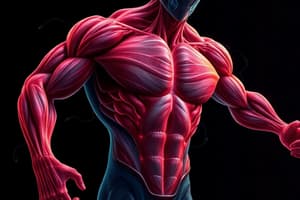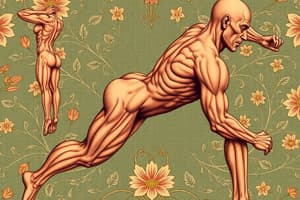Podcast
Questions and Answers
What initiates the process of muscle contraction?
What initiates the process of muscle contraction?
- The interaction of actin and myosin
- The release of calcium ions from the sarcoplasmic reticulum (correct)
- The shortening of the muscle fibers
- The binding of ATP to myosin heads
During isotonic contraction, which of the following statements is true?
During isotonic contraction, which of the following statements is true?
- Muscle length remains constant while force changes
- There is no change in muscle length or force
- Muscle generates maximum force at all lengths
- Muscle length changes while force remains constant (correct)
What happens when ATP binds to the myosin head during muscle contraction?
What happens when ATP binds to the myosin head during muscle contraction?
- Myosin head detaches from actin and repositions (correct)
- Calcium ions are released from the sarcoplasmic reticulum
- Myosin head tilts and pulls actin fibers
- Myosin head attaches to actin at the binding site
In isometric contractions, which parameter is primarily measured?
In isometric contractions, which parameter is primarily measured?
Which of the following factors affects isotonic contractions?
Which of the following factors affects isotonic contractions?
Flashcards
Muscle Contraction: Step 1
Muscle Contraction: Step 1
An action potential arrives at the motor end-plate, triggering the release of calcium ions ($Ca^{2+}$) from the sarcoplasmic reticulum.
Muscle Contraction: Step 2
Muscle Contraction: Step 2
$Ca^{2+}$ binds to troponin, causing a shift in the troponin-tropomyosin complex. This exposes the actin binding site on the actin fibers.
Muscle Contraction: Step 3
Muscle Contraction: Step 3
Myosin heads bind to the exposed actin binding site. The myosin head then tilts (and loses phosphate from ATP). ADP/ATPase is now bound. This pulls the actin fiber.
Isotonic Contraction
Isotonic Contraction
Signup and view all the flashcards
Isometric Contraction
Isometric Contraction
Signup and view all the flashcards
Study Notes
Muscle Contraction Steps
- Action potential triggers calcium release from sarcoplasmic reticulum
- Calcium binds to troponin, moving tropomyosin and exposing actin binding sites
- Myosin heads bind to actin, forming cross-bridges
- Myosin heads pivot, pulling actin filaments (power stroke)
- ATP binds to myosin, causing detachment of cross-bridges
- Myosin heads return to resting position (recovery stroke)
- Cycle repeats as long as calcium is present
Isotonic and Isometric Muscle Contraction
Isotonic Contraction
- Constant Force: Muscle shortens while maintaining a constant force (e.g., lifting a weight).
- Displacement: Measures the change in muscle length
- Mass Hanging: Increased mass hanging on the muscle leads to a decrease in the amount of shortening, increases latent period.
- Overcoming Load: The muscle must overcome the attached weight
- Increased Latent Period: This causes more delay between the trigger and the contraction.
- Muscle Shortening: Constant force leads to a decrease in muscle shortening
Isometric Contraction
- Constant Length: Muscle length does not change.
- Force Generation: Measures the force generated during contraction
- Tension Development: The muscle develops tension but doesn't shorten - holding a weight in a static position.
Studying That Suits You
Use AI to generate personalized quizzes and flashcards to suit your learning preferences.




